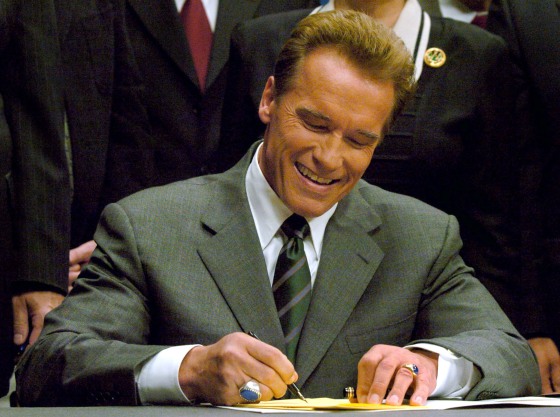In his biggest victory since taking office last month, Gov. Arnold Schwarzenegger on Friday signed a fiscal recovery plan that will put a $15 billion bond measure and new spending restrictions on the March ballot.
The bills, crafted by Schwarzenegger and Democratic leaders, were approved by the Senate earlier Friday, a day after the Assembly approved them. Schwarzenegger and legislative Republicans had pushed for tougher economic measures, but Democrats, who control both houses, blocked their attempts last week.
“Today, I’m a happy governor,” Schwarzenegger said during a signing ceremony attended by legislative leaders. “The recovery plan that I’m about to sign, I’m very happy about because both parties came together.”
“This is a compromise,” Senate Republican Leader Jim Brulte said. “What it does is force this state to begin to live within our means. This bill is better than the current situation.”
Senators voted 35-5 for the spending restrictions; the 27-12 vote for the bonds was just enough to get that measure on California’s March ballot.
Spending limits
The package has many provisions, including a mandate that spending cannot exceed revenues in any year. Long-term borrowing to pay operating expenses would not be allowed, except for the $15 billion bond.
The governor would have the authority to force lawmakers to deal with a fiscal emergency by calling a special session and stopping all other business until solutions are adopted.
The Legislature also would have to create a reserve fund. Starting in 2006-07, lawmakers would be required to set aside 1 percent of general fund revenues into a “rainy day” fund and increase the set aside each year until the fund reaches $8 billion.
The $15 billion in bonds would be issued to finance the state’s deficit. The debt would be repaid in nine years by diverting a quarter-cent portion of the state’s existing sales tax. If approved by voters, the bonds will replace about $13 billion in bonds that are included in the current budget, but are in jeopardy of being ruled unconstitutional by pending court challenges.
Critics call plan a sham
The spending limits were applauded in some corners, but some senators called the plan a sham.
“The people of this state two months ago voted for a change,” said Sen. Sam Aanestad, R-Grass Valley. “There were expectations that we would be done with business as usual and I’m disappointed. This bill has no meaningful reform.”
While the spending reforms aren’t as strict as some would like, they’re a good first step, some finance experts said.
“The agreement does not address most of the major long-term issues,” said Stephen Levy of the Center for Continuing Study of the California Economy. “It does not address the question of whether to raise taxes, impose cuts or a combination of the two. It does put the parties in the state on record saying that we will adopt a balanced budget and we will no longer use borrowing to make up deficits.”
Stabilization a goal
Jean Ross, executive director of the California Budget Project, said the changes will help stabilize California’s up-and-down economy.
“This calls for a reserve fund and in that manner forces the Legislature to put money aside. I think that is a big deal,” Ross said.
Schwarzenegger originally called for a hard spending cap that grows only with the rate of inflation and population. Democrats called that plan too restrictive, saying that starting such measures in a poor economic year would mean the state could never restore cut programs during better times.
After the defeat of his original proposal last Friday, Schwarzenegger softened his demands. This week he agreed to a compromise proposal very similar to what the Democrats originally offered.
